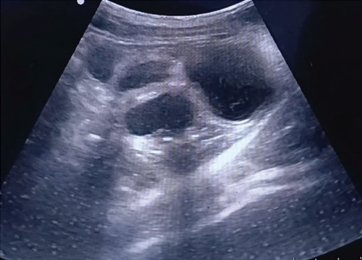-
Adopt
-
Veterinary Care
Services
Client Information
- What to Expect – Angell Boston
- Client Rights and Responsibilities
- Payments / Financial Assistance
- Pharmacy
- Client Policies
- Our Doctors
- Grief Support / Counseling
- Directions and Parking
- Helpful “How-to” Pet Care
Online Payments
Emergency: Boston
Emergency: Waltham
Poison Control Hotline
-
Programs & Resources
- Careers
-
Donate Now
 By Matthew Araujo, VMD
By Matthew Araujo, VMD![]()
angell.org/emergency
emergency@angell.org
617-522-7282
August 2025
Introduction
Pyometra is defined as the acute or chronic suppurative inflammation of the uterine wall. It is commonly characterized by cystic dilation of the endometrial glands (CEH) and accumulation of neutrophil-rich exudate in the uterine lumen. Often, pyometra begins with mild, local signs that, if not treated promptly, can escalate into more life-threatening disease, including peritonitis, sepsis, and multi-organ dysfunction syndrome (MODS).
Etiology and Pathogenesis
These are still two of the highest-researched topics regarding pyometra, as it is a multifactorial disease that is still not completely understood. Most often, pyometra occurs during the luteal phase (usually within two months after estrus), when progesterone levels have peaked. During diestrus, the increased progesterone levels upregulate the secretory activity of the endometrial glands, promote proliferation of the endometrium, and induce cervical closure. At the same time, they downregulate myometrial contractility and the local leukocyte response. This local environment provides reduced uterine resistance to bacterial infection and an escalated risk of pyometra. It is hypothesized that these effects accumulate with each subsequent cycle.
In this environment, bacterial colonization is typically the cause of pyometra; however, some reports indicate that up to 20% to 25% of patients with pyometra do not grow any bacterial isolates on uterine culture at the time of diagnosis. Of those bacterial species isolated, E. coli is predominant in both canines and felines. Other bacterial isolates include Staphylococcus Spp., Streptococcus Spp., Proteus Spp., Klebsiella Spp., and Pseudomonas Spp. at far lower rates.
Prevalence and Clinical Presentation
Pyometra is the most prevalent reproductive disease in both dogs and cats. It is estimated that up to one in four intact female dogs are affected by pyometra, predominantly seen in middle-aged to older dogs. However, juvenile pyometras can and do occur at lower rates. Higher incidence rates in older dogs are thought to be associated with repeated estrous cycles, as stated above. Studies have shown varied and no conclusive evidence for a clear breed predisposition to pyometra.
The most common presenting clinical signs for dogs affected by pyometra include vaginal discharge, polyuria/polydipsia, lethargy/depression, abdominal discomfort/distension, anorexia, vomiting, diarrhea, and fever. In severe and advanced cases, patients can suffer from signs of sepsis and shock, including weakness/collapse, severe dehydration, pale mucous membranes, tachycardia, tachypnea, and weak peripheral pulses.
Diagnosis
Diagnosis is made by a combination of history, clinical signs, and abdominal imaging. Bloodwork can be beneficial in supporting a diagnosis of pyometra and, more importantly, assessing the patient’s systemic health. Overall, Ultrasonography is the most helpful diagnostic tool for identifying pyometra. Often, distended fluid-filled loops of the uterus are visible on ultrasound adjacent to the urinary bladder. However, the differential diagnosis of mucometra and hydrometra has been noted to appear similarly on ultrasound. Strictly speaking, a definitive diagnosis of pyometra is made and verified through postoperative macroscopic and histologic examination of the uterus and ovaries, as well as microbiological examination of the uterine content.

Ultrasound Imaging of a confirmed case of canine pyometa. The Patient’s Urinary Bladder (UB) is visible adjacent to distended loops of uterine horn in transverse section, indicated by an asterisk (*). Reddy et. al. J. Andaman Sci. Assoc. 29 (2 ):2024
Treatment and Prognosis
In cases of pyometra, ovariohysterectomy is strongly recommended as a definitive treatment. Although medical therapy for cases of open pyometra is sometimes considered in a young, systemically stable, and healthy breeding animal, it will not be discussed in this article. In cases of pyometra, pre-operative evaluation and stabilization are paramount. Oftentimes, patients require correction of systemic consequences of pyometra mentioned above. Patients are often in need of intravenous fluid therapy, antibiotic therapy, antiemetic and anti-nausea medication, and pain medication. In general, a broad-spectrum antibiotic is started. A common first-choice medication at the time of diagnosis is Clavamox. Although an appropriate choice, a fluoroquinolone antibiotic, such as Enrofloxacin, should be considered if available, given the most common reported bacterial isolates and its broad spectrum of coverage against gram-negative bacteria. Subsequent antimicrobial choices should be guided by culture and sensitivity results.
Overall prognosis for cases of pyometra without the presence of uterine rupture is excellent, with one study reporting a survival rate of 97% in dogs treated surgically. Many studies suggest severe azotemia at the time of diagnosis as a negative prognostic indicator. Acute uterine rupture increases the overall mortality rate to approximately 50%, and sometimes higher, depending on the progression and timing of a subsequent septic abdomen.
References
- Barsanti JA: Genitourinary infections. Infectious Diseases of the Dog and Cat, 4th ed. Elsevier Saunders, St. Louis, MO 2012 pp. 1031-36.
- Hagman R: Pyometra in Small Animals. Vet Clin North Am Small Anim Pract 2018 Vol 48 (4) pp. 639-61.
- Dow. The cystic hyperplasia-pyometra complex in the bitch, J Comp Pathol, 69 (1959), pp. 237-250.
- Hagman, C. Greko. Antimicrobial resistance in Escherichia coli isolated from bitches with pyometra and from urine samples from other dogs, Vet Rec, 157 (2005), pp. 193-196
- Hollinshead F, Krekeler N: Pyometra in the queen: To spay or not to spay? J Feline Med Surg, 2016;18:21-33.
- M. Agostinho, A. de Souza, R.P. Schocken-Iturrino, et al. Escherichia coli strains isolated from the uteri horn, mouth, and rectum of bitches suffering from pyometra: virulence factors, antimicrobial susceptibilities, and clonal relationships among strains, Int J Microbiol, 2014 (2014), p. 979584.
- Xavier RGC, Santana CH, Sanches da Silva PH, et al: Association between bacterial pathogenicity, endometrial histological changes, and clinical prognosis in canine pyometra. Theriogenology 2024 Vol 214 (0) pp. 118-23.
- Bertero A, Corrò M, Spagnolo E, et al: Antimicrobials administration, treatment outcome and bacterial susceptibility in canine pyometra cases subjected to ovariohysterectomy. Vet J 2024 Vol 306 (0) pp. 106157.
- Arora N, Sandford J, Browning GF, et al: A model for cystic endometrial hyperplasia/pyometra complex in the bitch. Theriogenology 2006 Vol 66 (6-7) pp. 1530-36.
- Jipean S, Ambrosen A, Emanuelson U, et al: Closed cervix is associated with more severe illness in dogs with pyometra. BMC Vet Res 2017 Vol 13 (1) pp. 11.
- Pailler S, Slater MR, Lesnikowski SM, et al: Findings and prognostic indicators of outcomes for bitches with pyometra treated surgically in a nonspecialized setting. J Am Vet Med Assoc 2022 Vol 260 (S2) pp. S49-S56.
- Pailler S, Slater MR, Lesnikowski SM, et al: Findings and prognostic indicators of outcomes for queens with pyometra treated surgically in a nonspecialized hospital setting. J Am Vet Med Assoc 2022 Vol 260 (S2) pp. S42-S48.
- Hiew MWH, Loi SDY: Clinical Presentation, Diagnosis, Treatment and Outcome of 77 Dogs and 137 Cats with Pyometra. World Small Animal Veterinary Association Congress Proceedings 2018.
- Turkki OM, Sunesson KW, den Hertog E, et al: Postoperative complications and antibiotic use in dogs with pyometra: a retrospective review of 140 cases (2019). Acta Vet Scand 2023 Vol 65 (1) pp. 11.
- Hagman R, Lagerstedt AS, Hedhammar Å, et al: A breed-matched case-control study of potential risk-factors for canine pyometra. Theriogenology 2011 Vol 75 (7) pp. 1251-57.
- McCobb E, Dowling-Guyer S, Pailler S, et al: Surgery in a veterinary outpatient community medicine setting has a good outcome for dogs with pyometra. J Am Vet Med Assoc 2022 Vol 260 (S2) pp. S36-S41.